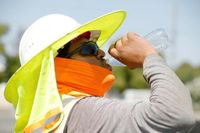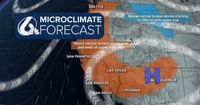California is in the grip of a relentless heat wave, with temperatures shattering records up and down the state and prompting a cascade of warnings from meteorologists and public health officials. As of Friday, August 22, 2025, heat advisories and extreme heat warnings blanketed much of the Bay Area, Central Coast, and Southern California, with forecasters cautioning that the oppressive weather would linger through the weekend and possibly beyond. The effects are being felt from the foggy shores of San Francisco to the sunbaked valleys of Santa Barbara and the deserts of the Southwest.
According to the National Weather Service, the current heat wave has outlasted initial predictions, with advisories now extended through Sunday, August 24. "It's still going to be very warm—well above normal—through the weekend. The evenings are going to be very warm as well," meteorologist Ryan Kittell told the Los Angeles Times. The slow cooling trend means little respite for Californians, especially those without access to air conditioning.
On Thursday, August 21, the Central Coast saw high temperatures soar to record-breaking levels in several locations. As reported by KSBW, a new record of 95°F was set, surpassing the previous high of 92°F from 1997. The heat wasn’t isolated to just one area. In the Bay Area, at least seven cities notched new daily records, according to SFGATE. Santa Rosa and San Rafael both hit 100°F, breaking marks set just six years ago, while Concord reached 101°F, its hottest August 21 in more than a decade. Livermore climbed to 102°F, edging past its 2009 high, and Redwood City, Hayward, and Oakland all set new benchmarks in the mid-80s to upper 90s.
The weather pattern fueling this scorcher is a stubborn high-pressure system parked over the region. As KSBW noted, this system is keeping the marine layer offshore, resulting in clear skies and minimal humidity. Winds have been light in the mornings but pick up in the afternoons, especially in valleys, mountains, and along the coast. The result? Temperatures running about five degrees warmer than the previous day in some places, and highs soaring 10-15 degrees above normal for this time of year.
The heat has not been confined to the daytime. Many areas, particularly in the L.A. Basin, experienced nighttime temperatures that barely dipped below 70°F, as highlighted by the Los Angeles Times. This lack of nighttime relief is especially dangerous, as it prevents the body from recovering after sweltering days. The Weather Prediction Center warned, "Extreme heat is dangerous even at night when temperatures don’t cool down. Without A/C or cooling, the body can’t recover, increasing the risk of heat illness."
Public officials have responded by opening additional cooling centers in Los Angeles and extending hours at air-conditioned sanctuaries. Residents have been urged to stay hydrated, avoid strenuous activities during peak heat, and check on vulnerable neighbors. "This is the kind of heat that’s going to affect people that are particularly susceptible to heat-related illness," Dalton Behringer, a Bay Area meteorologist, told SFGATE. "If you have elderly neighbors or friends or family, check up on them."
Along with the health risks, the heat wave has heightened the threat of wildfires across the state. The Los Angeles Times reported that the Pickett Fire in Napa County exploded to 2,133 acres with no containment as of Friday, forcing evacuations and sending massive smoke plumes skyward. Cal Fire reiterated, "Heat also means fire danger," and red flag warnings remain in effect through Sunday for the L.A. and Ventura County mountains and foothills.
Fire weather concerns are particularly acute in the interiors of Santa Barbara County and southern San Luis Obispo County, where an Extreme Heat Warning and a Fire Weather Watch are in place through Sunday night, as detailed by KSBY. Temperatures in these regions are expected to reach upwards of 105°F, with gusty offshore winds and low humidity increasing the risk of rapid fire spread. The Gifford Fire burn zone is among the areas under close watch.
To reduce wildfire risk, Southern California Edison has considered planned power shutoffs for about 10,000 customers across six counties, though none had been initiated as of Friday. The threat of monsoonal thunderstorms looms as well, with the National Weather Service forecasting hazards such as localized winds, flooding, debris flows, and the ever-present risk of dry lightning through at least Monday, August 25. These storms are most likely in the mountains and deserts, but even the North Bay faces a "low chance" of dry lightning overnight from Friday into Saturday, according to SFGATE.
Air quality has also become a concern, with the Bay Area Air District issuing advisories for Sonoma, Napa, and Solano counties due to smoke from the Pickett Fire. Onshore winds are expected to keep most wildfire smoke aloft, but residents are advised to remain vigilant, especially those with respiratory issues.
While Friday and Saturday are expected to bring continued heat—San Francisco temperatures ranged from 62°F at Ocean Beach to 87°F in the Castro District on Friday, per KSBW—forecasters anticipate a gradual cooldown starting early next week. "Temperatures are going to slide a little bit as we go through the weekend, not much, maybe a few degrees, but a gradual cooldown, and then we’ll be back closer to normal by next week," Behringer told SFGATE. But as Kittell pointed out, "By the time we get into Tuesday, Wednesday we’ll start to get back to around normal—which is still warm."
For now, Californians are being asked to stay weather-aware, take precautions against heat illness, and remain on alert for fire and power disruptions. The combination of record-breaking temperatures, relentless sunshine, and minimal nighttime relief has made this heat wave a formidable test for the state’s residents and infrastructure.
As the weekend unfolds, all eyes are on the skies and the thermometers, hoping for a break in the pattern and a safe passage through one of the hottest stretches in recent memory.

